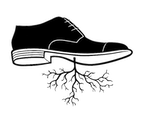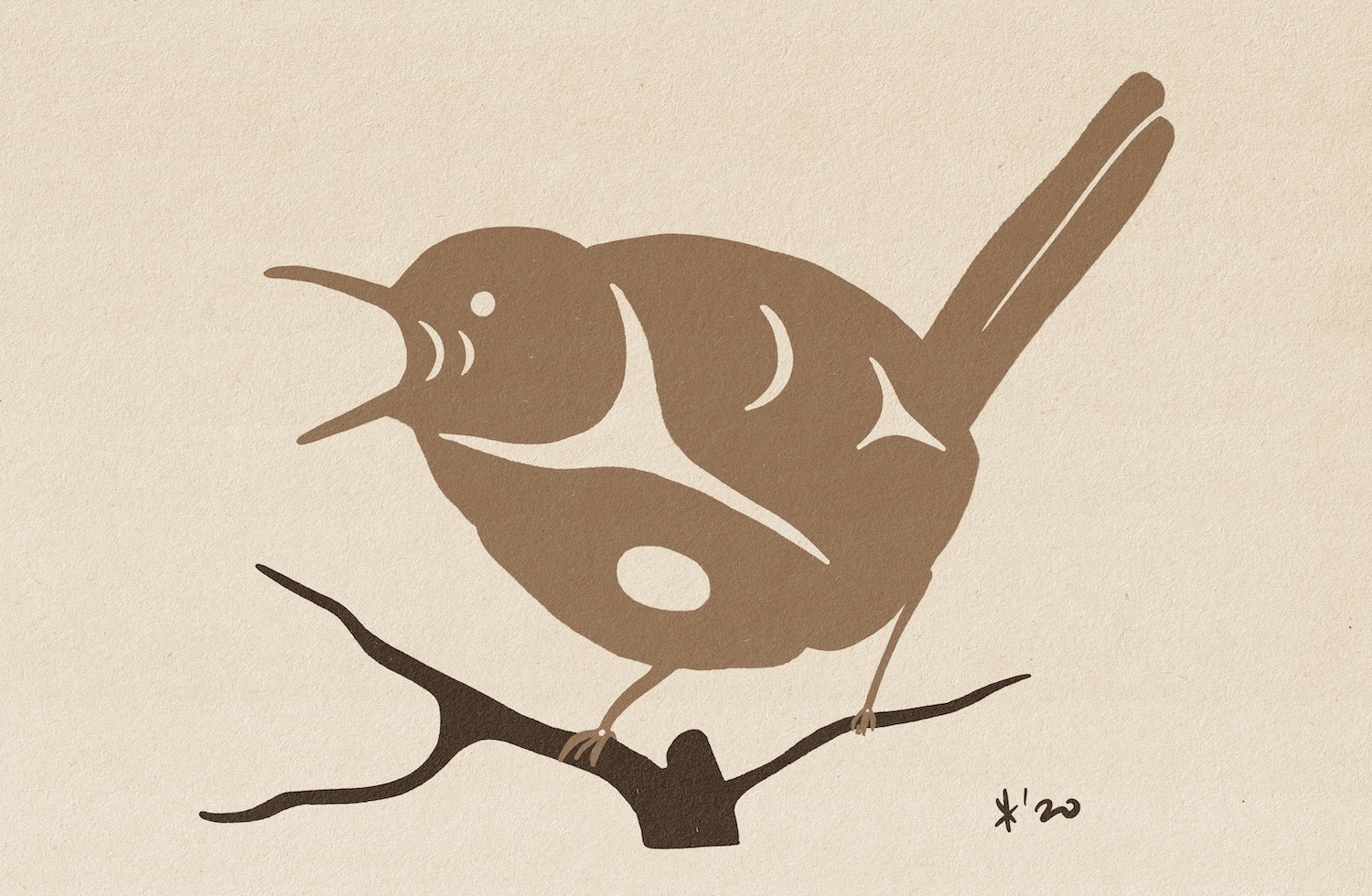
The previous issue of Five Dials was illustrated by artist Eliot White-Hill, Kwulasultun. His work combines aspects of the traditional techniques of the Coast Salish, the Indigenous peoples of the Pacific Northwest, with modern themes. For instance, the depiction of a figure tossing a mysterious liquid down its gullet might, at first glance, look traditional until the viewer reads the title: The Coffee Drinker. The artworks we published in Five Dials, including Tutumiye’ (Little Wren Shrieks of Existential Dread) are each connected to Coast Salish life. We welcomed the chance to speak to the artist about their origins, as well as some of the important issues facing Indigenous artists today, including reconciliation.
Five Dials spoke to White-Hill, Kwulasultun over Zoom on a day when the air was warm, the birds shrieked outside, and most humans had been told to stay home. The pandemic had forced us all to come to terms with a particular brand of solitude.
Five Dials
How have you handled all the solitude in the past year?
Eliot
For us, solitude plays such a significant part when a person is looking for help or guidance, or if they’re training or preparing themselves. They’d go and bathe in the mountains, sometimes for multiple days in a row. It’s all very intimate and personal. They’d welcome what comes when they’re alone.
That said, there’s been a little bit too much solitude this past year.
Five Dials
Let’s start over with an introduction.
Eliot
I’ll introduce myself the traditional way. O si:em nu siyeyu, entha pe Kwulasultun tu ni cun utl Snuneymuxw. Huy ce:p qu kwuns ulup sqaqip utunu kweyul. So that is: My name’s Kwulasultun and I come from the Snuneymuxw people.And I’m so grateful to be with you today talking.
It’s important to me to begin work that way, to frame the conversation by showing where I’m coming from and who I am. I practise Coast Salish art, our traditional art form, here in the Pacific Northwest. Coast Salish art is unique among the different peoples here. My art was featured in Five Dials 58.

Five Dials
What are you trying to explore with your art?
Eliot
Who we are and where we come from and the way our ancestors saw the world. And the way we continue to exist here, surviving and thriving despite colonization and despite everything that we’ve had to overcome.
Five Dials
What should readers know about Coast Salish art?
Eliot
When people think of Indigenous art from the Pacific Northwest, it’s usually going to be something called formline, a technique that uses ovoid shapes, high contrast, and positive and negative space. Coast Salish art is kind of the opposite of that. Instead of the interior negative space, everything is filled in.
Five Dials
How would you describe traditional Coast Salish techniques?
In traditional Coast Salish art, you have your figure, a silhouette, whether an animal or a human or whatever it is. You’re afforded a lot of creative freedom with the silhouette. It’s always going to be a little bit different from individual to individual.
You would then fill the silhouette in with Coast Salish shapes: the crescent and the circle and the trigon, which is like a triangular crescent—a shark tooth. There’s a grammar to the way that these designs are used.
Most often the shapes are used to depict the flow of motion or energy within the design or the body. The orientation of the figures is important in the Coast Salish world. We do things from right to left or counter- clockwise. In the design on the cover of the previous issue, the crescents flow down the line where the spine would be. That’s really old-school Coast Salish design.
All of it is intrinsically tied to our identity — who we are and where we come from and its use within ceremony and ritual. The carvings aren’t just decorations; they’re specific references and stories about either the artist or the family who owned the piece.
It’s so tied to ritual that it’s almost not an art form. When you think about what art is and the goal of making something that’s beautiful, or expressing something visually— this is different, almost an ascetic kind of art.
Five Dials
Does modern Coast Salish art bend or break the traditional rules?
Eliot
It’s best to understand the rules before you break them. Once you understand how it’s supposed to look, then you can start experimenting. There’s a philosophical principle in Coast Salish culture that we call Uy Shqwaluwun, which means ‘to be of good mind’. It’s the state you have to go into and maintain when you’re making art, or even in your everyday life. You try to keep the bad energy away.
It’s about being present and opening yourself and connecting with the world around you, the people around you. When you can achieve that, the art will come.
My great-grandma would say that if you’re making something, you talk to that thing. If you’re weaving with cedar bark, talk to the cedar bark and tell it what you’re doing. Ask it to help you, because that way it will open itself to you. That’s when the connection happens. With my art, I try to keep that in mind while working on pieces, even if I’m drawing on my iPad. It’s still engaging with this almost metaphysical concept of where our teachings come from.
My great-grandmother, Dr Ellen White Kwulasulwut, was an amazing person, an educator and a linguist and a healer, such a dynamo. I realized how spoiled I’d been, being able to go and sit with her all the time and just listen to her.
After she passed, I started researching and reading everything that I could find about Coast Salish culture, from the old ethnographic texts and documents and colonial records.That’s what drove me. All these different textbooks and accounts—they have facts and tidbits about who we are, but to understand us, you must turn to our own forms of self-expression.
I learned how hard it is to find our history. Take the word Snuneymuxw. Over the years, people have called us ten or fifteen different versions. In order to research, you have to know all of those different versions just to access information about us.
Then there are all the different ways that our language, Hul’qumi’num, has been written or described. One of the earlier texts is an informal journal kept by a missionary priest named Thomas Crosby who lived here in our community, in Snuneymuxw, in the 1800s. It’s a book called Among the An-ko-me-nums of the Pacific Coast. That’s what they called us at the time: An-ko-me-nums. A bastardization of Hul’qumi’num. And then Coast Salish people from this part of the world were called different things by different people who came here. You begin to realize, if you don’t know the names that have been placed upon you, you won’t access that part of your history.
There are all these barriers and gates. It’s the part of the erasure, the impact of colonization and colonialism. They didn’t want the knowledge to continue. So much of the way we’re talked about in these old texts is how we’re going extinct. These researchers thought they were doing work on a people who wouldn’t exist in a hundred years.
We’re still here. We’re still here and we’re still connecting with the land and we’re still connecting with who we are.
Five Dials
Do you think settlers are daunted by the prospect of learning about Indigenous culture?
Eliot
I think so, and sometimes it comes down to just pronouncing stuff. One of the things I hear all the time is the use of x in Hul’qumi’num, which is a guttural sound, like a Scottish och, you know. People see an x on a sign and they just give up. Like: I can’t figure this out. How can we overcome that?
Five Dials
Where do you think we’re at with reconciliation?
Eliot
It’s tough with reconciliation and the government’s inability to follow through
on the promises that they’ve made. That’s something that weighs heavily on me because it has an immediate impact on us and our land. I look at the pipelines that are being forced through, the total disrespect for our relationships, for our sovereignty as nations.
But one of the most important things is that we stop looking at reconciliation as something that’s just going to happen and is on the horizon. Instead, we have to look at it as a relationship that unfolds moment by moment, instant by instant. There must be a change in how we walk together as people on an individual-to-individual level, as well as a change in the way that we interrelate as nations on a national level.
It’s a chance for people to re-evaluate the way they think and act in relation to Indigenous peoples and in relation to the land that they’re on, a chance to start thinking critically about what we’ve been taught.
It is moment to moment. If you’re in a situation, it’s about being present and asking yourself: is my behaviour changing the narrative? Or is it just framing the narrative? How am I participating as somebody who’s here?
Five Dials
There’s a lot of playfulness in your work, too. How much of the modern world do you inject into the designs?
Eliot
So much of my practice is trying to be present. I live in the modern world and so I draw a lot of inspiration from the modern world. But I try to speak to modern settings where the supernatural is creeping in. It’s not just a strictly traditional supernatural. There’s a tongue-in-cheek metaphysical kind of weirdness too. I love absurdist humour, I was obsessed with Monty Python growing up.
So many of our traditional designs are deferential to beings or supernatural states or emotional states. It got me thinking: what are some of these modern-day states?Who are the supernatural beings of the modern day? One design, The Coffee Drinker, is a representation of a person slamming coffee. They become a supernatural being who embodies a heightened state.
Then there’s my wren design, Little Wren Shrieks of Existential Dread. How do we know what birds are chirping about? Why do we think they’re so happy? Maybe this wren is just screeching, you know, just letting it out.
Five Dials
Does this approach help you from becoming too reverential?
Eliot
Tradition, while it is so important to us, isn’t always going to be perfect. We’re human. Where can we start to poke fun at ourselves? We have to be able to look at ourselves and be critical, but not in a harsh, hateful way. We have to examine all these different ways to open up the conversation and talk about our culture in a way that hasn’t been really talked about before. Certainly not in the history of Canada.◊

